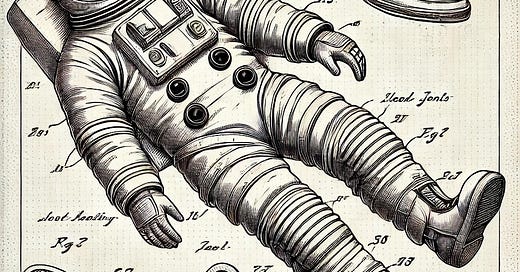Body of the claim is what follows the transitional phrase
It's where the action happens
One quirky feature of patent law is the "single sentence" rule—where the claim's body does the heavy lifting of what gets into that one packed sentence. Ironically, sometimes the body can be just one word long: Perfiuoroperhydrocoronene (claim 12 of US3775489A).
As the part of the claim that follows the preamble and the transitional phrase, the body of the claim is the place where the action is. The body typically consists of (1) elements and (2) the way they interact with each other structurally, physically or functionally creating the invention that is unique.
If the body of the claim does not explain how the elements interact with each other, then it functions like a grocery list where the order of items is irrelevant and no action is described. However, when the elements are interconnected in a meaningful way, the body of the claim resembles a gourmet recipe rather than just a list of ingredients.
Depending on the class of the claim, the body is where the main elements, processes, parts, substances, articles, combinations etc are brought to life.
Faber states one of the important rules in drafting the body of the claim: Never introduce a new claim element in the middle of describing another element, nor describe actions involving a new elements before properly introducing it.
The following illustration demonstrates the principle on introducing new elements:
Correct Example:
“A mechanical pencil comprising:
a hollow barrel;
a lead-advancing mechanism positioned within said barrel; and
an eraser attached to one end of said barrel.”
(All elements are introduced separately and clearly.)
Incorrect Example (violating the principle):
“A mechanical pencil comprising:
a hollow barrel containing a lead-advancing mechanism having a spring wrapped around a push button extending outward.”
(The “spring” and “push button” are introduced improperly in the middle of describing the “lead-advancing mechanism,” rather than separately.)
The following illustration demonstrates the principle of introducing elements first and then their actions:
Correct Example:
“A stapler comprising:
a base;
an arm pivotally connected to said base; and
a staple magazine coupled to said arm, wherein said arm moves said staple magazine toward said base.”
(Each element is introduced before describing actions involving it.)
Incorrect Example (violating the principle):
“A stapler comprising:
a base;
an arm pivotally connected to said base, moving a staple magazine toward said base.”
(The “staple magazine” is described performing an action before being properly introduced as an element.)
Body is also the place where the limitations to the inventions are detailed. The body should include all the elements and limitations that distinguishes it from the prior art.
Some of the limitations can unnecessarily narrow down the scope of the invention. Slusky mentions 4 types of limitations that can get into the preamble and the body of the claim: (1) Descriptive labels and modifiers; (2) Unnecessary elements; (3) Advantages of the invention; and (4) Intended use of the invention.
Notes:
Claim 12 of US3775489A https://patents.google.com/patent/US3775489A/en
Slusky, Ronald D. Invention Analysis and Claiming: A Patent Lawyer’s Guide, Second Edition. Second edition. Chicago: American Bar Association, 2013.
Faber, Robert C. Faber on Mechanics of Patent Claim Drafting. 7th edition. Practising Law Institute, 2017.




